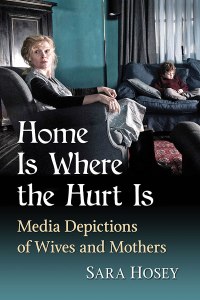Book Review: Home is Where the Hurt Is by Sara Hosey
- schiffnerhs
- Jan 5, 2021
- 3 min read
Hosey, Sara. Home is Where the Hurt Is: Media Depictions of Wives and Mothers. McFarland, 2019.
Book review by Katherine Allocco (Western Connecticut State University)

Sara Hosey’s excellent book Home is Where the Hurt Is analyzes shifting media images of mothers and wives in recent film and television shows emphasizing the ways that stereotypes and established tropes about domestic violence and feminine disempowerment are slowly evolving and creating new opportunities for more complex and less anti-feminist depictions of women’s spaces and power in popular culture. Focusing primarily on media from the last three decades, Hosey analyzes shifting media consumption patterns coupled with changing social and financial roles that American women have either embraced or been forced into and concludes that current trends have mostly benefited American women by allowing a greater diversity of voices to contribute to conversations about abuse, marginalization and violence against women. She interrogates the ways that post-feminism, consumerism, and media have shaped feminist thought about domesticity and violence in American media.
Hosey begins with a very expert and satisfying introduction in which she clearly contextualizes her work within current feminist theory by surveying the past twenty years of feminist scholarship, clarifies her own theory and position in feminist thought, and explains why she chose the sources that she did. Hosey then organizes her book into two sections “Hurt” and “Hope”. In “Hurt,” her four chapters offer an in-depth analysis of film and television from the past thirty years that illustrate how entrenched negative depictions of motherhood are and how consistently women characters are ignored or charmingly bullied on screen. She draws her examples from American Horror Story, The Babadook, Twilight, The Hunger Games, Teen Mom, Gilmore Girls, Enough, and Waitress demonstrating how American audiences have been deeply conditioned to doubt women’s words and actions and how even the most seemingly unconventional characters still often become victims of horrific violence and have little recourse for help or escape. Her chapters in the section titled “Hope” are, of course, somewhat more optimistic. Hosey analyzes key scenes from Big Little Lies, Madea’s Family Reunion, Tully, The Handmaid’s Tale, Obvious Child, and Tiny Furniture to show how cinematic and televised depictions of mother-daughter relationships, women’s mental health crises, women’s responses to violence, and a victims’ self-loathing increasingly offer more nuance and self-reflection to viewers, although she remains well aware of the holes and flaws in many of these characters and scripts. Hosey remains rather critical of post-feminism generally noting that its tendency to imagine a rosier world of opportunity often masks the very real problems of the wage gap, access to childcare, and of course, the constant threat of rape and violence that many women regularly face, just to name a few. Hosey frequently ties her popular culture analysis to current political issues and concerns showing readers how Kellyanne Conway’s public comments about abuse reflect outdated pop culture trends and how news images of representation and gender identity can shape the ways that pop culture images are read by critics and audiences.
Hosey’s book is beautifully organized and written. Each chapter begins with a clear declaration of her argument, an explanation of how the current chapter ties to her thesis, clearly constructed sections that describe a specific film or show, and then careful, meticulous analysis revealing how that show supports her chapter’s argument and the book’s thesis. She concludes each chapter with an insightful, succinct conclusion. The overall tone of the book is smart, sharp, and sensitive; in no place is the author didactic or heavy-handed. Hosey very successfully constructs a sophisticated argument that reflects the evolution of feminist thought and theory, and illuminates the weaknesses of post-feminist analysis and pop culture. Her book recognizes the hard work still left for feminists to pursue.
This book would work well in many undergraduate or graduate courses in Women’s and Gender Studies, Communication and Media Studies, History, American Studies, Sociology, or Psychology. Furthermore, Hosey has organized this book so beautifully and constructed such a tight and through argument that this book would also work well in any course that teaches or emphasizes student writing. Home is Where the Hurt Is would also be enjoyable and enlightening reading for a general audience and will inspire any reader to re-watch old favorites with a deeper understanding and new perspective.





Comments